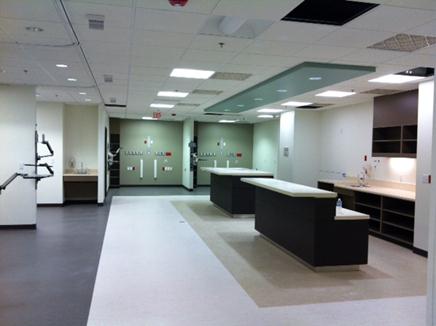Energy Solutions in Healthcare Construction
The big energy savings story in healthcare revolves around building control systems, especially those designed around lighting and temperature controls, and of course the growing utilization—and mainstreaming—of LED fixtures throughout the facility.

LED fixtures light a Nurse Station at Mercy's Orthopedic Hospital in Springfield, MO.
For example, with unit costs having moderated substantially, LED lighting usage is expanding in health care facilities for the simple reason that the fixtures themselves provide significantly longer life, lower heat output and offer greater design flexibility than traditional lighting systems. What’s more, with advanced dimming controls and programmability, LEDs are rapidly being integrated into building automation systems (BAS), bringing considerable flexibility with respect to dimming and sensing control options.
With LEDs More and Better Light Ends Up Costing Less
Among the benefits are the significantly lower voltages required to power LED systems, which lower expense, but they also reduce the heat generated by the lighting system. This has enabled the downsizing of feeders as well as branch wiring; it’s also meant that more fixtures can be used per circuit, actually increasing the net lumens available while lowering the cost of powering more lights. It also helps that less heat means less need for cooling by the HVAC system. Add occupancy sensors, timers and an array of automated lighting controls and there are tremendous advantages to making the transition to integrated LED systems and lighting controls.
Meanwhile, with all the advances in performance and improved cost effectiveness, health care environments remain inherently challenging spaces in terms of the critical tasks they’re asked to perform. It is crucial, for example, to have sufficient task illumination for patient exams, diagnostics and treatment, as well as for surgery. Lighting systems need to deliver on demand, appropriate ambient light levels for safe navigation and way-finding. They also need to provide versatility for patient comfort.
Lighting Controls Systems Leading to Improved Patient Care
As technology advances have brought less invasive procedures, the effect on inpatient care has been to enhance patient centered care as more procedures and examinations can be conducted in the patient room itself. As a consequence, lighting systems have had to become more versatile — addressing more different tasks in a given space. On one hand, the improved “dialability” of individual room controls enables more granular individualized lighting choices serving the room as needed, on the other these same controls are built into a networked lighting control system whose controls can flexibly operate at either the room level or through a centralized location such as a nurse station, via an integrated system control device.
Mixing in Daylight Harvesting
The “dialability” of room management controls will soon enable patients to control their lights and window shades from their hospital bed. Bringing new and substantial energy savings, innovative shading control systems are now available, combining daylight harvesting with lighting system controls tied-in to the central building management system. Together, these combined systems are further reducing energy consumption and optimizing the quality of light in the spaces where they’re applied; in many cases these combined systems can save up to 60 percent in energy costs related to lighting.